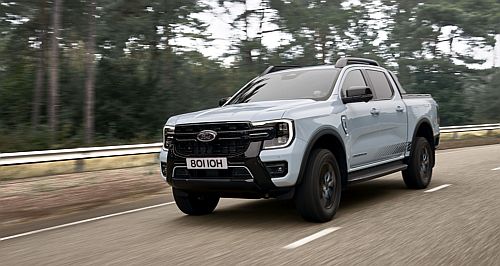Details firm on Ford’s Ranger PHEV

FORD revealed further specifications and technical details for the Ranger plug-in hybrid (PHEV) during the model’s public debut at the IAA Transport Show in Hannover, Germany overnight.
The electrified Ford Ranger combines a 2.3-litre turbocharged four-cylinder petrol engine with a 75kW electric motor and 11.8kWh (net) battery providing up to 45km of all-electric driving range plus up to 6.9kW of vehicle-to-load capacity for powering tools, appliances and camping equipment.
It is due in Aussie showrooms in early 2025 – and just months behind the BYD Shark plug-in hybrid ute and potentially around the same time as GWM’s just-confirmed Cannon Alpha PHEV.
Ford's claimed electric-only driving range for the Ranger PHEV is less than half that of the Chinese BYD and GWM offerings, which sacrifice payload for battery capacity.
Braked towing capacity remains unaltered from the rest of the Ranger line-up at 3500kg.
The Ranger sends drive from the petrol engine, electric motor or a combination of both through an advanced four-wheel drive system via Ford’s proven 10-speed automatic transmission.
A two-speed transfer case and a rear differential lock are provided for tough going, and the model offers familiar driver assistance modes from diesel variants.
“The Ranger PHEV delivers all the versatility and capability people expect from a Ranger,” said Ford Ranger PHEV chief engineer Rob Sharples.
“It can tackle tough terrain, tow a trailer with ease, be driven in town as an EV or, thanks to Pro Power Onboard be used as a mobile power plant when you’re off the grid.”
Mr Sharples said the Ranger PHEV’s parallel hybrid architecture enables the full combined power and torque of both the petrol engine and e-motor to be deployed simultaneously for enhanced performance on- and off-road.
“Not all hybrid vehicles are the same, and our mission was to ensure the Ford Ranger was as versatile and capable as possible,” he continued.
“Our engineering teams worked very hard on keeping Ranger’s core off-road capability while adding in the performance and efficiency of a hybrid powertrain.”
Utilising what Ford describes as a Modular Hybrid Transmission (or MHT) positioned between the petrol engine and automatic transmission, the unit consists of an e-motor and separator clutch nestled between the engine and transmission (forward of the torque converter), adding just 160mm to the transmission’s overall length.
Ford says the separator clutch allows torque from the internal combustion engine (ICE) to blend with torque from the e-motor for full hybrid performance and efficiency, or it can decouple the two propulsion systems and allow Ranger PHEV to be driven as a regular ICE vehicle or with electric propulsion only.
The e-motor housed in the MHT is said to provide additional torque, “an extra hit of power and regenerative braking to help improve fuel efficiency”, as well as supporting Pro Power Onboard when generator mode is active.
Ford says the system offers up to a maximum of 6.9kW with a cabin socket output of 2.3kW and two outlets in the load bed with an individual outlet limit of 3.45kW.
“The MHT is the key ingredient in ensuring Ranger PHEV delivers the capability we know our owners expect from a truck with a Ranger badge, along with enhanced versatility, impressive low-end torque and an overall faster-responding powertrain which means improved performance compared to regular Ranger,” added Mr Sharples.
“In high-demand situations, like overtaking, the combined power and torque of the petrol engine and e-motor can be sent to all four wheels.”
Mr Sharples said the Ranger PHEV powertrain offers the range and performance of a modern petrol engine alongside the efficiency of an electric vehicle thanks to an 11.8kWh (net) battery.
The traction battery sits neatly between specially engineered frame rails.
As with the majority of PHEVs on the road, the Ranger’s drive models offer all-electric driving capability and allows drivers to choose when and how they deploy battery power using either Auto EV, EV Now, EV Later or EV Charge modes.
When the battery reaches its lowest state of charge, the powertrain automatically reverts to Auto EV mode – supplementing petrol engine power with electric motor assistance using recaptured energy for optimised fuel efficiency.
In addition to its EV modes, Ranger PHEV’s Terrain Management System offers regular and off-road driving modes familiar to other four-wheel drive Ranger variants. These include Normal, Eco, Sport, Slippery, Tow/Haul, Mud/Ruts and Sand – with each drive mode featuring a unique graphical display in the 8.0-inch instrument cluster.
The drive modes also “fine tune” throttle, transmission, and traction control response for “enhanced performance”, says Ford, while the low-range transfer case and rear locking differential ensure “excellent off-road capability”.
Additionally, Sport mode – borrowed from the Ranger Raptor – is said to help customers get the most from the EcoBoost petrol engine by enhancing throttle response and holding lower gears for improved acceleration.
“Whether you’re driving around town, exploring the world beyond the bitumen or working or camping off-grid, Ranger PHEV delivers the capability we know our owners expect, along with the added efficiency of a hybrid powertrain, and the versatility offered by Pro Power Onboard,” concluded Mr Sharples.